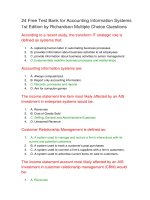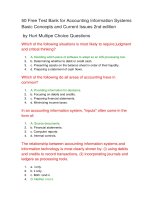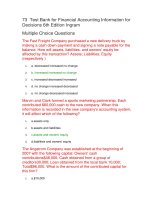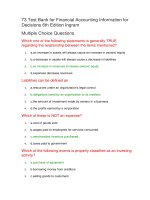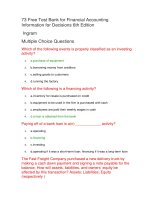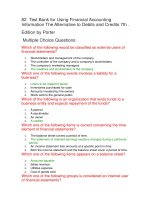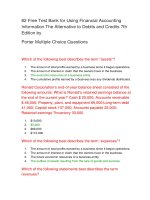138 test bank for financial accounting 10th edition by harrison
Bạn đang xem bản rút gọn của tài liệu. Xem và tải ngay bản đầy đủ của tài liệu tại đây (151.27 KB, 35 trang )
138 Test Bank for Financial Accounting 10th Edition
by Harrison
Multiple Choice Questions
Advantages of a corporation include:
1.
A) each stockholder can enter into agreements that legally bind all the
stockholders.
2.
B) the double taxation of distributed profits.
3.
C) limited liability of the stockholders for the corporation's debts.
4.
D) each stockholder can conduct business in the name of the corporation.
All of the following are true statements about the entity assumption
EXCEPT for:
1.
A) the entity assumption draws a sharp boundary around each entity.
2.
B) the transactions of the business cannot be combined with the transactions
of the owner.
3.
C) the entity assumption ensures that the business will continue indefinitely.
4.
D) under the entity assumption, the entity is any organization that stands apart
as a separate economic unit.
Which of the following is a TRUE statement about the
characteristics of partnerships?
1.
A) Limited partners have mutual agency and unlimited liability for the
partnership's debts.
2.
B) General partners have mutual agency and limited liability for the
partnership's debts.
3.
C) Net income and loss of the partnership "flows through" to the partners.
4.
D) The partnership agreement must be in writing.
The fair value of a plant asset is equal to:
1.
A) the amount the business could sell the asset for.
2.
B) the amount of cash paid plus the dollar value of noncash consideration
given in exchange for the plant asset at acquisition.
3.
C) the amount of cash paid plus the loan taken out to finance the purchase of
the plant asset.
4.
D) the amount a company can receive for the asset when sold in order to go
out of business.
Information must be sufficiently transparent so that it makes sense
to reasonably informed users of the financial statements, such as
creditors. This qualitative characteristic of information is called:
1.
A) verifiability.
2.
B) faithful representative.
3.
C) relevant.
4.
D) understandability.
Which type of business organization transacts the most business
and is the largest in terms of assets, income, and number of
employees?
1.
A) Proprietorship
2.
B) Partnership
3.
C) Limited-liability company
4.
D) Corporation
Which statement is TRUE about partnerships?
1.
A) Legally, a partnership is separate from the partners.
2.
B) A partnership has one capital account.
3.
C) For accounting purposes, a partnership is separate from the partners.
4.
D) For accounting purposes, a partnership is not separate from the partners.
The ________ is elected by the stockholders and is responsible for
setting policy and appointing officers.
1.
A) board of directors
2.
B) chief executive officer (CEO)
3.
C) chief financial officer (CFO)
4.
D) advisory council
An important fact to consider when determining how to organize a
business is that:
1.
A) members of an LLC have unlimited liability and are taxed like members of
a partnership.
2.
B) for accounting purposes, a proprietorship is a distinct entity from the
proprietor.
3.
C) the records of a partnership can include each partner's personal assets
and debts.
4.
D) the proprietor and the proprietorship are separate legal entities.
Characteristics of faithfully representative information do NOT
include:
1.
A) complete.
2.
B) neutral.
3.
C) accurate.
4.
D) relevant.
Which statement is FALSE?
1.
A) International Financial Reporting Standards are used by many countries in
the world.
2.
B) U.S. Generally Accepted Accounting Principles are used by many
countries in the world.
3.
C) The Financial Accounting Standards Board is working with the International
Accounting Standards Board to develop similar accounting standards.
4.
D) For many years, U.S. Generally Accepted Accounting Principles were
considered to be the superior set of accounting standards in the world.
Which of the following have unlimited liability for a company's
debts?
1.
A) owners of a corporation
2.
B) members of a limited liability company
3.
C) limited partners in a limited liability partnership
4.
D) general partner in a limited liability partnership
The entity assumption does NOT apply to a:
1.
A) proprietorship.
2.
B) limited liability partnership.
3.
C) limited-liability company.
4.
D) The entity assumption applies to all the above.
Which of the following statements is TRUE for a proprietorship?
1.
A) Legally, a proprietorship is separate from the proprietor.
2.
B) For accounting purposes, a proprietorship is separate from the proprietor.
3.
4.
C) For accounting purposes, a proprietorship is not separate from the
proprietor.
D) A and B
Owners of an LLC are called:
1.
A) partners.
2.
B) proprietors.
3.
C) members.
4.
D) stockholders.
Enhancing qualitative characteristics of accounting information do
NOT include:
1.
A) comparability.
2.
B) verifiability.
3.
C) timeliness.
4.
D) materiality.
To be useful, accounting information must have the fundamental
qualitative characteristics of:
1.
A) comparability and relevance.
2.
B) relevance and faithful representation.
3.
C) materiality and understandability.
4.
D) faithful representation and timeliness.
In 1960, Johnson Company purchased a building for $100,000. In
2013, a real estate professional says the building has a fair value of
$1,000,000. In 2013, a similar building down the street recently sold
for $900,000. What value is reported for the building on the balance
sheet at December 31, 2013?
1.
A) $100,000
2.
B) $550,000
3.
C) $900,000
4.
D) $1,000,000
Which of the following statements is TRUE for a limited liability
company?
1.
A) Members have unlimited liability for the debts of the business.
2.
B) Members have limited liability for the debts of the business.
3.
C) Only the limited partners have limited liability for the debts of the business.
4.
D) The general partner has unlimited liability for the debts of the business.
Which of the following statements is FALSE?
1.
A) The Securities and Exchange Commission is investigating whether all U.S.
public companies should adopt International Financial Reporting Standards.
2.
B) The advantage of a uniform set of global accounting standards is that
financial statements from a U.S. company will be comparable to those of a
foreign company.
3.
C) In the long run, a uniform set of global accounting standards will reduce the
costs of doing business globally.
4.
D) With a uniform set of global accounting standards, companies will have to
produce multiple versions of their financial statements.
Decision makers who use accounting information include:
1.
A) creditors.
2.
B) the Internal Revenue Service.
3.
C) the Securities and Exchange Commission.
4.
D) all of the above.
Which of the following statements is TRUE for a limited liability
partnership?
1.
A) The partners all have limited liability for the debts of the partnership.
2.
B) The partners all have limited liability for the acts of the other partners.
3.
C) The general partner has unlimited liability for the debts of the partnership.
4.
D) The limited partners have unlimited liability for the debts of the partnership.
Shareholders of a corporation:
1.
A) have limited liability for the corporation's debts.
2.
B) have unlimited liability for the corporation's debts.
3.
C) have unlimited liability for the actions of other stockholders.
4.
D) receive dividends from the corporation without having to pay tax on the
distribution.
In order to compare the financial statements of Toyota Corporation
to the financial statements of General Motors, it would be preferable
to use _________.
1.
A) U.S. Generally Accepted Accounting Principles for General Motors and
International Financial Reporting Standards for Toyota.
2.
B) U.S. Generally Accepted Accounting Principles for both companies.
3.
C) International Financial Reporting Standards for both companies.
4.
D) U.S. Generally Accepted Accounting Principles for Toyota Corporation and
International Financial Reporting Standards for General Motors.
The process of verifying accounting information in financial
statements is undertaken by:
1.
A) the Securities and Exchange Commission.
2.
B) internal auditors only.
3.
C) external auditors only.
4.
D) internal and external auditors.
A company uses LIFO to determine the cost of goods sold each
year. This inventory method always results in the lowest possible
net income. This is an example of:
1.
A) cost benefit constraint.
2.
B) materiality.
3.
C) verifiability.
4.
D) consistency.
The International Accounting Standards Board is responsible for
establishing:
1.
A) the code of professional conduct for accountants.
2.
B) the Securities and Exchange Commission.
3.
C) Generally Accepted Accounting Principles used in the United States.
4.
D) International Financial Reporting Standards.
Which of the following entities pays federal income taxes?
1.
A) limited liability partnership
2.
B) general partnership
3.
C) limited liability company
4.
D) corporation
Federal income taxes are paid by ________ in a limited liability
company.
1.
A) the company
2.
B) limited partners only
3.
C) general partners only
4.
D) members
A disadvantage of general partnerships is:
1.
2.
3.
4.
A) double taxation of distributed profits.
B) the partnership's assets are commingled with each partner's personal
assets.
C) state rules and regulations must be followed.
D) each partner may conduct business in the name of the entity and make
agreements that legally bind all partners.
Accounting:
1.
2.
A) measures business activities.
B) processes data into reports and communicates the data to decision
makers.
3.
C) is often called the language of business.
4.
D) is all of the above.
Which of the following is a CORRECT statement about GAAP and
IFRS?
1.
A) IFRS prefers valuing assets at historical cost while GAAP prefers using fair
value.
2.
B) IFRS is more "rules-based" than GAAP.
3.
C) The FASB and the IASB are working towards convergence of standards.
4.
D) The SEC will require all companies to use IFRS beginning in 2013.
Which of the following statements is TRUE for a limited liability
partnership?
1.
A) The partnership pays no federal income taxes.
2.
B) Only the limited partners pay federal income taxes on their shares of the
partnership's profits.
3.
C) Only the general partner pays federal income taxes on his or her share of
the partnership's profits.
4.
D) Only the members pay federal income taxes on their shares of the
partnership's profits.
The two types of accounting are:
1.
A) profit and nonprofit.
2.
B) financial and managerial.
3.
C) internal and external.
4.
D) bookkeeping and decision-oriented.
138 Free Test Bank for Financial Accounting 10th
Edition by Harrison Multiple Choice Questions - Page 2
The accounting equation can be stated as:
1.
A) Assets + Stockholders' Equity = Liabilities.
2.
B) Assets -Liabilities = Stockholders' Equity.
3.
C) Assets = Liabilities - Stockholders' Equity.
4.
D) Assets - Stockholders' Equity + Liabilities = Zero.
The assets of a company:
1.
A) must equal the liabilities of the company.
2.
B) include property, plant, and equipment and accounts payable.
3.
4.
C) represent economic resources that are expected to produce a future
benefit.
D) include short-term investments and notes payable.
At the end of the current accounting period, account balances were
as follows: Cash, $25,000; Accounts Receivable, $40,000;
Common Stock, $18,000; Retained Earnings, $14,000. Liabilities for
the period were:
1.
A) $13,000.
2.
B) $20,000.
3.
C) $27,000.
4.
D) $33,000.
A construction company paid $80,000 cash for equipment used in
the business. At the time of purchase, the equipment had a list price
of $90,000. When the balance sheet was prepared, the fair value of
the equipment was $83,000. At what amount should the equipment
be reported on the balance sheet of the company?
1.
A) $80,000
2.
B) $83,000
3.
C) $85,000
4.
D) $90,000
Which of the following statements is TRUE?
1.
A) Dividends are expenses of a business.
2.
B) Dividends reduce retained earnings.
3.
C) Dividends increase retained earnings.
4.
D) Dividends reduce net income.
All of the following are expenses EXCEPT for:
1.
A) Cost of Goods Sold.
2.
B) Depreciation Expense.
3.
C) Salary Expense.
4.
D) Dividends.
Net income:
1.
A) is calculated by subtracting total expenses and total dividends from total
revenues.
2.
B) occurs when total revenues are less than total expenses.
3.
C) is often referred to as the "bottom line" on an income statement.
4.
D) decreases total stockholders' equity.
The principle stating that assets acquired by the business should be
recorded at their actual cost on the date of purchase is the:
1.
A) historical cost principle.
2.
B) objectivity principle.
3.
C) reliability principle.
4.
D) stable dollar principle.
Net income is computed as:
1.
A) revenues - expenses - dividends.
2.
B) revenues + expenses.
3.
C) revenues - expenses.
4.
D) revenues - expenses + dividends.
On January 1, 2015, total assets for Wininger Technologies were
$135,000; on December 31, 2015, total assets were $155,000. On
January 1, 2015, total liabilities were $110,000; on December 31,
2015, total liabilities were $115,000. What is the amount of the
change and the direction of the change in Wininger Technologies'
stockholders' equity for 2015?
1.
A) Decrease of $15,000
2.
B) Increase of $15,000
3.
C) Increase of $30,000
4.
D) Decrease of $30,000
The owners' equity of any business is equal to:
1.
A) revenues minus expenses.
2.
B) assets minus liabilities.
3.
C) assets plus liabilities.
4.
D) paid-in capital plus assets.
When total expenses exceed total revenues, the result is:
1.
A) a net profit.
2.
B) a net loss.
3.
C) a dividend.
4.
D) excess cash.
Revenues were $150,000, expenses were $140,000, and cash
dividends declared and paid were $5,000. What was the net income
and the change in retained earnings for the period?
1.
A) Net income was $10,000; the change in retained earnings was $10,000.
2.
B) Net income was $150,000; the change in retained earnings was $15,000.
3.
C) Net income was $10,000; the change in retained earnings was $5,000.
4.
D) Net income was $150,000; the change in retained earnings was $145,000.
Census Company had the following accounts and balances at the
end of the year. What are total liabilities at the end of the year?
Cash $74,000; Accounts Payable $12,000; Common Stock
$21,000; Cost of Goods Sold $85,000; Dividends Declared and
Paid $12,000; Operating Expenses $12,000; Accounts Receivable
$50,000; Inventory $40,000; Long-term Notes Payable $33,000;
Revenues $90,000; Salaries Payable $24,000
1.
A) $12,000.
2.
B) $45,000.
3.
C) $66,000.
4.
D) $69,000.
Property, plant and equipment does NOT include:
1.
A) buildings.
2.
B) land.
3.
C) machinery.
4.
D) patent.
Revenues are:
1.
A) decreases in assets resulting from delivering goods or services to
customers.
2.
B) increases in liabilities resulting from delivering goods or services to
customers.
3.
C) increases in retained earnings resulting from delivering goods or services
to customers.
4.
D) decreases in retained earnings resulting from delivering goods or services
to customers.
The relevant measure of the value of the assets of a company that
is going out of business is the:
1.
A) liquidating value.
2.
B) inflation-adjusted book value.
3.
C) historical cost.
4.
D) book value.
The CEO of Clarkson Company owns a vacation home in Hawaii.
Clarkson Company owns a factory in Detroit where they are
headquartered. Which of these properties is considered an asset(s)
of the business?
1.
A) Only the vacation home in Hawaii
2.
B) Only the factory in Detroit
3.
C) Both the vacation home in Hawaii and the factory in Detroit
4.
D) Neither the vacation home in Hawaii nor the factory in Detroit
The major types of transactions that affect retained earnings are:
1.
A) paid-in capital and common stock.
2.
B) assets and liabilities.
3.
C) revenues, expenses, and dividends.
4.
D) revenues and liabilities.
Which of the following increases retained earnings?
1.
A) Net loss
2.
B) Net income
3.
C) Expenses
4.
D) Dividends
Receivables are classified as:
1.
A) increases in earnings.
2.
B) decreases in earnings.
3.
C) liabilities.
4.
D) assets.
Which of the following must be added to beginning Retained
Earnings to compute ending Retained Earnings?
1.
A) Net income
2.
B) Expenses
3.
C) Dividends
4.
D) All of the above
Historical cost:
1.
2.
A) is determined for each asset on a yearly basis.
B) is equal to the amount of cash paid less the dollar value of all non-cash
consideration given in the exchange.
3.
C) is a verifiable measure that is relatively free from bias.
4.
D) is the amount that the business could sell the asset for.
The stable monetary unit assumption:
1.
A) ensures that accounting records and statements are based on the most
reliable data available.
2.
B) holds that the entity will remain in operation for the foreseeable future.
3.
C) maintains that each organization or section of an organization stands apart
from other organizations and individuals.
4.
D) enables accountants to ignore the effect of inflation on the accounting
records.
Expenses of a business include:
1.
A) sales and cash equivalents.
2.
B) common stock and rent expense.
3.
C) cost of goods sold and salaries expense.
4.
D) retained earnings and utilities expense.
An entity's equity consists of two accounts, Amy Jones, Capital, and
Mindy Lenz, Capital. This indicates the entity is a:
1.
A) proprietorship.
2.
B) corporation.
3.
C) not-for-profit.
4.
D) partnership.
Another way to state the accounting equation is:
1.
A) Assets = Liabilities + Paid-in Capital - Common Stock.
2.
B) Assets + Liabilities = Stockholders' Equity.
3.
C) Assets = Liabilities + Paid-in Capital + Retained Earnings.
4.
D) Assets = Liabilities - Paid-in Capital - Dividends.
Liabilities are:
1.
A) a form of paid-in capital.
2.
B) future economic benefits to which a company is entitled.
3.
C) debts payable to outsiders called creditors.
4.
D) the outflow of resources that decrease common stock.
The accounting assumption that states that the business, rather
than its owners, is the reporting unit is the:
1.
A) entity assumption.
2.
B) going concern assumption.
3.
C) stable-monetary-unit assumption.
4.
D) historical cost assumption.
If a company prepares its financial statements three years after the
end of their accounting period, they have violated the qualitative
characteristic of:
1.
A) understandability.
2.
B) timeliness.
3.
C) verifiability.
4.
D) materiality.
Golden Company had the following accounts and balances at the
end of the year. What are total assets at the end of the year?Cash
$74,000; Accounts Payable $12,000; Common Stock $21,000; Cost
of Goods Sold $85,000; Dividends Declared and Paid $12,000;
Operating Expenses $12,000; Accounts Receivable $50,000;
Inventory $40,000; Long-term Notes Payable $33,000; Revenues
$90,000; Salaries Payable $24,000
1.
A) $74,000
2.
B) $114,000
3.
C) $124,000
4.
D) $164,000
Verifiability means that the information:
1.
A) is timely and understandable.
2.
B) is understandable.
3.
4.
C) must be capable of being checked for accuracy, completeness and
reliability.
D) is material and relevant.
Examples of liabilities include:
1.
A) accounts payable and dividends.
2.
B) accounts payable and common stock.
3.
C) investments and note payable.
4.
D) accounts payable and note payable.
138 Free Test Bank for Financial Accounting 10th
Edition by Harrison Multiple Choice Questions - Page 3
All of the following will appear on the income statement EXCEPT
for:
1.
A) assets.
2.
B) expenses.
3.
C) gains.
4.
D) revenues.
Which financial statement answers the following question: What is
the company's operating performance over the past year?
1.
A) statement of cash flows
2.
B) income statement
3.
C) statement of retained earnings
4.
D) balance sheet
A company's interest expense for the period is reported on the:
1.
A) balance sheet.
2.
B) income statement.
3.
C) statement of cash flows.
4.
D) statement of retained earnings.
Beck Company had the following accounts and balances at the end
of the year. What is net income or net loss for the year?Cash
$74,000; Accounts Payable $12,000; Common Stock $21,000; Cost
of Goods Sold $85,000; Dividends Declared and Paid $12,000;
Operating Expenses $12,000; Accounts Receivable $50,000;
Inventory $40,000; Long-term Notes Payable $33,000; Revenues
$90,000; Salaries Payable $24,000
1.
A) Net income of $90,000.
2.
B) Net income of $78,000.
3.
C) Net loss of $7,000.
4.
D) Net income of $5,000.
Cost of goods sold:
1.
A) is considered a selling expense.
2.
B) is the direct cost of the product sold.
3.
C) is classified as revenue on the income statement.
4.
D) is the same as gross profit.
The balance sheet reports information about:
1.
A) revenues, expenses, and equity.
2.
B) liabilities, equity, and expenses.
3.
C) assets, revenues, and liabilities.
4.
D) assets, liabilities, and owners' equity.
Cash dividends declared:
1.
A) decrease revenue on the income statement.
2.
B) decrease retained earnings on the statement of retained earnings.
3.
C) increase expenses on the income statement.
4.
D) decrease operating activities on the statement of cash flows.
Which financial statement reports cash payments and cash receipts
over a period of time?
1.
A) statement of retained earnings
2.
B) income statement
3.
C) balance sheet
4.
D) statement of cash flows
If an investor wants to know a company's cash balance at the end
of the year, this balance is reported on the:
1.
A) balance sheet.
2.
B) statement of cash flows.
3.
C) income statement.
4.
D) A and B.
A company reports the purchase of equipment for $1,000,000 in
cash. On a statement of cash flows, this is a(n) example of:
1.
A) cash outflow from financing activity.
2.
B) cash outflow from operating activity.
3.
C) cash outflow from investing activity.
4.
D) noncash activity.
Michael Company reports the following account balances at the end
of the first year of operations: Revenues $99,000; Cost of Goods
Sold $40,000; Salaries Expense $13,000; Dividends Declared and
Paid $12,000; Utilities Expense $11,000; Advertising Expense
$10,000; Short-term Investments $20,000; Cash $30,000; Land
$50,000; Common Stock $50,000. What are total liabilities at the
end of the first year?
1.
A) $37,000
2.
B) $50,000
3.
C) $62,000
4.
D) $100,000
On the statement of retained earnings:
1.
A) a net loss is shown in parentheses as a deduction.
2.
B) net income decreases retained earnings.
3.
C) dividends declared increase retained earnings.
4.
D) dividends paid increase retained earnings.
Gerald Company has the following account balances at the end of
the first year of operations: Revenues $99,000; Cost of Goods Sold
$40,000; Salaries Expense $13,000; Dividends Declared and Paid
$12,000; Utilities Expense $11,000; Advertising Expense $10,000;
Short-term Investments $20,000; Cash $30,000; Land $50,000;
Common Stock $50,000. what are total assets at the end of the first
year?
1.
A) $30,000
2.
B) $50,000
3.
C) $100,000
4.
D) $199,000
Seidner Company had the following account balances at the end of
the first year of operations:Revenues $99,000; Cost of Goods Sold
$40,000; Salaries Expense $13,000; Dividends Declared and Paid
$12,000; Utilities Expense $11,000; Advertising Expense $10,000;
Short-term Investments $20,000; Cash $30,000; Land $50,000;
Common Stock $50,000. What is the amount of net income or net
loss for the year?
1.
A) $25,000
2.
B) $35,000
3.
C) $65,000
4.
D) $75,000
A company issues common stock for $100,000. On a statement of
cash flows, this will be reported as a(n):
1.
A) financing cash flow.
2.
B) investing cash flow.
3.
C) operating cash flow.
4.
D) noncash activity.
The income statement:
1.
A) is not dated.
2.
B) must cover only a month in time.
3.
C) covers a defined period of time.
4.
D) reports the results of operations since the inception of the business.
The balance sheet contains the:
1.
A) amount of net income or net loss.
2.
B) beginning balance in retained earnings.
3.
C) ending balance in retained earnings.
4.
D) amount of cash dividends paid to stockholders.
An example of an operating expense is:
1.
A) cost of goods sold.
2.
B) sales returns.
3.
C) sales commissions paid to employees.
4.
D) interest expense.
A company sells travel mugs online for $9. They purchase the mugs
for $4 and charge the customers $2 for shipping and handling. Cost
of goods sold per mug is:
1.
A) $0.
2.
B) $2.
3.
C) $4.
4.
D) $6.
Which financial statement answers the following question: What is
the company's financial position?
1.
A) statement of cash flows
2.
B) income statement
3.
C) statement of retained earnings
4.
D) balance sheet
An investor wishing to assess the reasons for a change in retained
earnings over a period of a year would probably examine the:
1.
A) statement of cash flows and the income statement.
2.
B) income statement only.
3.
C) balance sheet.
4.
D) statement of retained earnings.
With regard to cash dividends:
1.
A) they must be paid on a yearly basis.
2.
B) the Board of Directors of the corporation determines if a dividend will be
paid.
3.
C) developmental-stage companies will pay large dividends to their
shareholders.
4.
D) a corporation must have enough paid-in capital and cash to pay dividends.
Which is the CORRECT order for items to appear on the income
statement?
1.
A) Revenues, operating expenses, net income
2.
B) Cost of goods sold, revenues, net income
3.
C) Revenues, net income, operating expenses
4.
D) Interest expense, revenues, operating income
The portion of net income that the company has kept over a period
of years and not used for dividends is called:
1.
A) common stock.
2.
B) retained earnings.
3.
C) revenue.
4.
D) gross profit.
Which statement(s) reports the revenues, gains, expenses, and
losses of an entity?
1.
A) Balance sheet
2.
B) Statement of cash flows and income statement
3.
C) Statement of retained earnings and statement of operations
4.
D) Income statement
The net income shown on the income statement also appears on
the:
1.
A) balance sheet and operations statement.
2.
B) statement of retained earnings.
3.
C) statement of cash flows, using the indirect method.
4.
D) B and C.
The balance sheet is also known as the:
1.
A) statement of profit and loss.
2.
B) operating statement.
3.
C) assets statement.
4.
D) statement of financial position.
What is an accounts payable?
1.
A) It is a liability for goods or services purchased on credit and supported by a
written agreement.
2.
B) It is a liability for goods or services purchased on credit and supported by
the credit standing of the purchaser.
3.
C) It is an amount of money to be received from a supplier.
4.
D) It is an asset arising from the sale of goods or services on credit.
When analyzing a company's income statement, a fact to
remember is that:
1.
A) cost of sales is another term for gross profit.
2.
B) operating expenses are the costs of everyday operations such as selling
expenses.
3.
C) companies are not allowed to offset items such as interest income and
interest expense against each other.
4.
D) net sales is equal to sales revenue less cost of goods sold.
The CORRECT data flow from one financial statement to the next
is:
1.
A) statement of retained earnings, income statement, balance sheet,
statement of cash flows.
2.
B) balance sheet, statement of retained earnings, income statement,
statement of cash flows.
3.
C) statement of retained earnings, income statement, statement of cash flows,
balance sheet.
4.
D) income statement, statement of retained earnings, balance sheet,
statement of cash flows.
A net loss occurs when:
1.
A) not enough cash exists.
2.
B) total revenues exceed total expenses.
